Report on the First World Congress on Combat Sports and Martial Arts
By Deborah Klens-Bigman, Ph.D.
(Editor's Note: Although the conference was held in March-April
2000, the author's report is important since it illustrates the unfortunate
and growing trend by many in the world to view martial arts on a purely
physical level devoid of its cultural heritage and philosophy.)
Amiens is a small town about an hour to the north and west of Paris.
It is picturesque, dominated by a large cathedral designated by the
United Nations as an object of "world heritage." Aside from
the cathedral, which can be seen for miles around from the surrounding
farmland, the chief interest of Amiens is that it is located in the
Somme, about 30 miles from one of the largest and bloodiest battles
of World War I - The First Battle of the Somme. Over 1 million casualties
were incurred on the British, French and German sides from July 1 to
November 13, 1916. The bodies of the dead were interred in massive cemeteries
near the battle site. The British thought this battle would end the
war, but they were mistaken, as the place became the site of bloody
combat again in 1918 (Encarta Online Encyclopedia 2000, n.p.). In spite
of the Somme being rural, many trades people speak English, owing to
the large number of British visitors seeking the graves of relatives
who left home long ago, and never returned.
Amiens was the setting for the Premiere Congres Mondial de Sports de
Combat et Arts Martiaux (First World Congress on Combat Sports and Martial
Arts), held from March 31 to April 2, 2000. Given its place in history,
Amiens was a fitting, or perhaps ironic location, depending on your
point of view.
There have been other conferences on martial arts. I recall hearing
about one held in India in the 1980's. A much smaller gathering took
place in Japan last year. 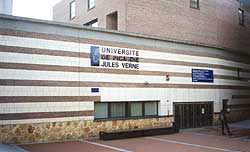 Given
that, I believe the Congress probably was the first of its kind in terms
of projected scope. It was sponsored by the Faculte des Sciences du
Sport of the Universite de Picardie Jules Verne, with additional sponsorship
provided by the Journal of Asian Martial Arts (JAMA). Conference facilities
were provided by the Universite, so presentations were given in a large
(and often cold) lecture hall on campus.
Given
that, I believe the Congress probably was the first of its kind in terms
of projected scope. It was sponsored by the Faculte des Sciences du
Sport of the Universite de Picardie Jules Verne, with additional sponsorship
provided by the Journal of Asian Martial Arts (JAMA). Conference facilities
were provided by the Universite, so presentations were given in a large
(and often cold) lecture hall on campus.
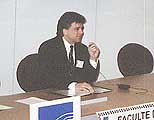 Michael
DeMarco, publisher and editor-in-chief of The Journal of Asian Martial
Arts (JAMA), gave the keynote address, "The importance of martial
arts research and practice in the world's new millennium," on Friday
afternoon. DeMarco spoke, among other things, about the possibility
of the good martial arts practice can do, not just for fitness, but
for health and even spiritual well-being of people of all ages around
the world (DeMarco's address is available in JAMA 9:2 (Summer 2000)).
Michael
DeMarco, publisher and editor-in-chief of The Journal of Asian Martial
Arts (JAMA), gave the keynote address, "The importance of martial
arts research and practice in the world's new millennium," on Friday
afternoon. DeMarco spoke, among other things, about the possibility
of the good martial arts practice can do, not just for fitness, but
for health and even spiritual well-being of people of all ages around
the world (DeMarco's address is available in JAMA 9:2 (Summer 2000)).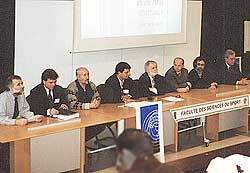 Oddly, the discussion that followed ended up with some of the Europeans
buttonholing the few Americans present regarding the surfeit of violence
in American society, and the prevalence (as they understood it) of Ultimate
Fighting contests. The Americans countered that Ultimate Fighting was
not "prevalent," and had, in fact, been banned in most states.
As small as this conflict was, it was illustrative of one of the many
divisions, as I saw it, between the US and Europe in terms of how martial
arts is seen, defined, analyzed and written about.
Oddly, the discussion that followed ended up with some of the Europeans
buttonholing the few Americans present regarding the surfeit of violence
in American society, and the prevalence (as they understood it) of Ultimate
Fighting contests. The Americans countered that Ultimate Fighting was
not "prevalent," and had, in fact, been banned in most states.
As small as this conflict was, it was illustrative of one of the many
divisions, as I saw it, between the US and Europe in terms of how martial
arts is seen, defined, analyzed and written about.
A large variety of papers had been accepted from around the world,
along with numerous poster presentations. However, in the end, though
billed as a "world congress," the participants were largely
French. That being the case, judo was the martial art form most often
discussed, being the most popular martial art/sport form in France.
Discussions of judo, and to a lesser extent, Taekwondo dominated the
proceedings from every conceivable physical angle, from "Anthropomorphic
determinants of kick force in Olympic Taekwondo athletes" (J. Hejmans),
to coaching strategies (G. Avanzini), to adapting judo for variously
disabled students (B. Gilles, J. Turpin, S. Cremieux et al.), to analysis
of different falls in judo (M. Dampenon) and many other physical aspects.
In total, about 40 papers and eight posters were presented. Papers were
accompanied by sophisticated PowerPoint graphics and streaming video.
Though I'm no expert, I feel I can say with some assurance that it was
probably the most thorough raking of the physical aspects of martial
arts (at least judo and Taekwondo) ever given in one place and time.
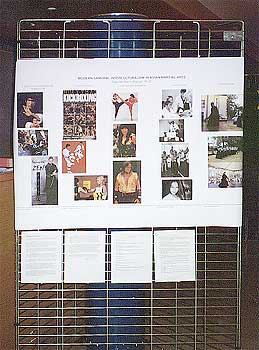
I was accepted to present a poster at the event, though as the proceedings
wore on, I realized that my topic, "Modern samurai: Interculturalism
in Asian martial arts," was entirely lost on the attendees, and
it wasn't the solely due to the language barrier. As the reaction to
Mike DeMarco's opening address made clear, the European participants
were simply not as interested in the social, cultural or even spiritual
aspects of martial art practice. Likewise, they were not interested
in more obvious issues that some of my US academic colleagues might
raise: gender and age issues, for example. I couldn't help but think
that if the next world congress were held in the US the proceedings
would be very different. The question remained, however, why weren't
these issues addressed in France?
In the first place, though there were three presentations scheduled
that specifically addressed "women" ("Les sports de combat
au feminin," by Claire Carrier, "Femmes et Boxe: un mise au
poing," a poster by C. Dorville and B. Gresser, and a poster analyzing
heart rate improvement in female Olympic Taekwondo team athletes) there
were only about five women in attendance, two of them being student
translators hired by the conference. The dearth of material addressing
women's history, current roles and legacy in martial arts simply didn't
exist because the women simply weren't there. There was ample material
for discussion, however. G. Avanzini's presentation on coaching judo
from the sidelines featured streaming video of a coach shouting from
his seat while two young women (one his student) wrestled on the mat.
The coach's student seemed to be afraid of her opponent, constantly
retreating, while her opponent bore down on her, as the coach bellowed
from the sidelines. Unfortunately, by the time Avanzini finished the
presentation, there was no real opportunity for questions due to time
constraints, but I have a few: Why was she afraid? Was she forced to
compete before she was ready? How did the coach follow up this episode
in the next class?
The issue of children came up in a few presentations, for example,
one that examined expectations of beginner karate students, but it was
eventually revealed that age didn't come up much because it was a given:
one presenter pointed out that 70% of French judoka are under 15 years
old. Given the potential danger of judo competition (unlike Taekwondo,
participants do not wear protective gear), I wondered what issues might
be contained there as well which were never addressed. One presentation
on the occurrence of skin lesions after judo practices ( D. Barrault)
suggested cleaning mats more often as a means of prevention (if my child
came home from the dojo with skin lesions, I might suggest she take
up soccer). At least the issue of older people taking up a martial art
was addressed by Yang Yang, a graduate student and Chen style taiji
practitioner who presented on a study done on older individuals who
took up taiji and its subsequent effect on heart rate and blood pressure
(incidentally, Yang Yang was one of the few Asians to present at this
world congress).
As I listened to paper after paper, I wondered why none of these other
issues were raised more fully. Additionally, none of the issues raised
by my poster - sportification, commercialization, fraud, and preservation
of koryu - were brought up at all. 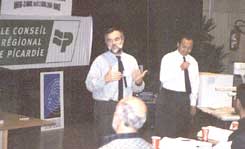 I
finally realized that the presenters, who were a pretty homogeneous
lot, were not dealing with any of these issues because they had already
decided among themselves, unconsciously or not, what the issues to be
addressed were. Unlike a more diverse group, the issues I was largely
concerned with had already been dealt with in some way, or perhaps in
the way I already mentioned: women didn't exist, children were a given,
and judo belongs to France.
I
finally realized that the presenters, who were a pretty homogeneous
lot, were not dealing with any of these issues because they had already
decided among themselves, unconsciously or not, what the issues to be
addressed were. Unlike a more diverse group, the issues I was largely
concerned with had already been dealt with in some way, or perhaps in
the way I already mentioned: women didn't exist, children were a given,
and judo belongs to France.
As it turned out, I was not the only person present who was less than
fully satisfied with the way the proceedings went. On Sunday afternoon,
the closing address was given by Mark Habersetzer. Though I was not
sure of his academic credentials, it was obvious that Habersetzer, a
graying but still large and powerful-looking man, was a martial arts
teacher of some status. He was the only participant whom I heard others
address as "sensei."
While he did not deal with some of the issues I had been wondering
about, Habersetzer did make up for some of the relentless focus on physicality
that had taken place up until this point. He took the congress participants
to task for ignoring exactly what I, and apparently others, had been
missing. He sat through three days of presentations, he said, without
hearing anything about the one aspect of martial arts practice that
set it apart from other activity--the spiritual aspects. Though he noted
we no longer lived in the middle ages, spiritual qualities of martial
arts practice can and should be taught as part of practice, through
a philosophy he called shin budo.
The tenets of shin budo include:
1. Knowledge is synonymous with technique, but with cultural background,
i.e., the historical and spiritual aspects - intact. Don't just teach
the technique, teach its background. Where did it come from? Why was
it developed?
2. Teaching should be the exchange of techniques among students and
practitioners. Teaching students should be "teaching ourselves;"
i.e., teachers can and should learn a great deal from their experience
of teaching.
3. Recognizing the difference between martial arts and combat sports:
| Martial
arts |
Combat
Sports |
|
Survival at stake
|
Play, Engagement
|
| Life
& Death |
Win
or Lose |
4. Use of "bunkai" & application - in martial arts to
gauge effectiveness of technique.
5. Deciding on other issues, for example:
| "do" |
v |
"jitsu"
(sic jutsu) |
| Opponent
is oneself |
|
Enemy outside
"A form of war"
|
Habersetzer stressed that the techniques, knowledge, and teaching methods
are different in martial arts as compared to combat sports, something
he felt the Congress participants had ignored. Moreover, tradition should
be central, though people should not become slaves to tradition, either.
Tradition "must serve man [sic], but not make him like a robot."
Instead, tradition needs to be adapted to become "tradition vivante"
- a living tradition.
Habersetzer pointed out that competitiveness and violence have changed
martial arts practice. Media violence and greater means of spreading
actual violence (availability of weapons, etc.) has accompanied the
world circulation of martial arts. Real martial arts practice involves
concepts such a definition of what you're doing - and response from
students - to do something and then answer questions from your students.
Habersetzer stated that if teachers stick to this approach their practice
will gain credibility.
With regard to competition, Habersetzer recalled his early days, when
he competed in tournaments, but participants also worked out together
and shared techniques. These aspects of martial arts practice are being
lost in the relentless interest in competition. To become a champion
is good, Habersetzer said, but the important part is, what are you doing
for humankind?
Habersetzer's remarks won on the applause meter, but they also sparked
some dissent. One participant became incensed, suggesting that the Congress
proceedings were "scientific," and that those looking for
spirituality could "go to the cathedral across the street."
Others countered that there was nothing "pure" about science,
and that it also had an agenda it endeavored to fulfill (the Americans
seemed to take the lead on that issue). After a period of debate, it
became clear that there would be no consensus on Habersetzer's remarks,
we were out of time, and the Congress drew to a close.
Afterwards, my thoughts kept drifting to the differences in approach
to martial arts practice even in my small experience; everything from
"traditions" being invented out of whole cloth in the US to
the simplicity of actual Japanese dojo I had visited, and all the places
in between. I thought about the cemeteries in the Somme, too, filled
with unwilling victims of the first truly modern war. Mike DeMarco's
"Editor's Notes" in the 9:2 issue of JAMA underscores the
historical aspect of the Congress being a first step to organize understanding
of martial arts study and practice on a world scale. Though a beginning,
the First World Congress on Combat Sports and Martial Arts only scratched
the surface of martial arts practice as a human activity related to
warfare, yet distinct from it. We had not even really defined our topic
very well (Is it a combat sport? A martial art? Both?). Though it took
until the very end of the Congress, I hope we realized that we cannot
take our assumptions on the subject for granted.
WORKS CITED
Avanzini, Gilbert
2000 "Analyse du coaching en judo comme activite situee"
paper given at the First World Congress on Combat Sports and Martial
Arts, Amiens, France, 2 April.
Barrault, Denys
2000 "Judo et rachis: consequences díune recherche federale"
paper given at the First World Congress on Combat Sports and Martial
Arts, Amiens, France, 31 March.
Carrier, Claire
2000 "Les sports de combat au feminin" paper to be
given at the First World Congress on Combat Sports and Martial Arts,
Amiens, France, 31 March.
Cremieux, S. et al.
2000 "Art martial activite adaptee pour personnes handicapees"
poster presentation at the First World Congress on Combat Sports and
Martial Arts, Amiens, France.
Dampenon, M.
2000 "Un obstacle a líapprentissage du judo: la LDS -
etude de cas pour des eleves de sixieme" paper given at the
First World Congress on Combat Sports and Martial Arts, Amiens, France,
1 April.
De Marco, Michael A.
2000 "The importance of martial arts research and practice in
the world's new millennium" Journal of Asian Martial Arts 9:2
pp. 9-17 (Summer 2000)
2000 "Editorís Notes" Journal of Asian Martial Arts
9:2 p. 4 (Summer 2000)
Dorville, C. and Gresser,B.
2000 "Femmes et Boxe: un mise au poing" poster listed
in the First World Congress on Combat Sports and Martial Arts program,
p.5.
Gilles, Bui-Xuan
2000 "Judo adapte" remarks given at the First World
Congress on Combat Sports and Martial Arts, Amiens, France, 31 March.
Habersetzer, Roland
2000 "Conference de synthese" remarks given at the
First World Congress on Combat Sports and Martial Arts, Amiens, France,
2 April.
Hejmans, J.
2000 "Anthropomorphic determinants of kick force in Olympic
Taekwondo athletes" paper given at the First World Congress
on Combat Sports and Martial Arts, Amiens, France, 31 March.
Klens-Bigman, Deborah
2000 "Modern samurai: Interculturalism in Asian martial arts"
Poster presentation given at the First World Congress on Combat Sports
and Martial Arts, Amiens, France.
Microsoft Encarta Online Encyclopedia 2000
2000 "Somme, Battles of the" http://encarta.msn.com,
n.p.
Turpin, J-P
2000 "Le judo: un espace díadaptation socio-cognative"
paper given at the First World Congress on Combat Sports and Martial
Arts, Amiens, France, 31 March.
About The Author:
Deborah Klens-Bigman is Manager and Associate Instructor of iaido at
New York Budokai in New York City. She has also studied, to varying
extents, kendo, jodo (short staff), kyudo (archery) and naginata (halberd).
She received her Ph.D in 1995 from New York University's Department
of Performance Studies where she wrote her dissertation on Japanese
classical dance (Nihon Buyo). and she continues to study Nihon Buyo
with Fujima Nishiki at the Ichifuji-kai Dance Association. Her article
on the application of performance theory to Japanese martial arts appeared
in the Journal of Asian Martial Arts in the summer of 1999. She is married
to artist Vernon Bigman.